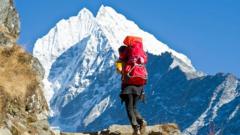Nepal is taking a bold step to rejuvenate tourism in its remote regions by offering free climbs to 97 of its Himalayan peaks over the next two years. This initiative comes alongside an imminent increase in permit fees for Mount Everest, which will rise to $15,000 (£11,170) from September – the first price hike in almost a decade.
The Nepalese tourism authorities aim to showcase the country's hidden travel gems and encourage exploration beyond the popular Everest circuit. With the mountainous region hosting the world’s ten tallest peaks, mountaineering is a vital revenue generator; last year, climbing fees yielded $5.9 million, with a staggering three-quarters attributed to Everest alone.
The newly free-to-climb peaks are nestled in Nepal’s Karnali and Sudurpaschim provinces, towering between 5,970m (19,590 ft) and 7,132m high. These provinces, located in the far western part of Nepal, rank among the nation’s poorest and least developed. As Himal Gautam, the director of Nepal's Tourism Department, noted, “Despite their breathtaking beauty, tourist numbers have remained low due to challenging access. We hope this new provision will help improve local economies and create jobs.”
However, the success of this initiative hinges on infrastructure enhancements and accessibility to these remote sites, as climbers have historically overlooked these peaks. In the past two years, only 68 climbers have opted for the 97 remote summits compared to 421 climbing permits granted for Everest in 2024 alone. Despite Everest's allure, it faces issues such as overcrowding and safety risks, prompting the Nepalese Supreme Court to propose a cap on climbing permits to preserve the mountains’ integrity.
Earlier this year, a significant 36% increase in Everest permit fees was announced, alongside a new law currently being debated by parliament. This law would require climbers to have previously summited a mountain over 7,000m within Nepal, framing the peaks in Karnali and Sudurpaschim as “ideal training grounds” for aspiring Everest climbers.
The Nepalese tourism authorities aim to showcase the country's hidden travel gems and encourage exploration beyond the popular Everest circuit. With the mountainous region hosting the world’s ten tallest peaks, mountaineering is a vital revenue generator; last year, climbing fees yielded $5.9 million, with a staggering three-quarters attributed to Everest alone.
The newly free-to-climb peaks are nestled in Nepal’s Karnali and Sudurpaschim provinces, towering between 5,970m (19,590 ft) and 7,132m high. These provinces, located in the far western part of Nepal, rank among the nation’s poorest and least developed. As Himal Gautam, the director of Nepal's Tourism Department, noted, “Despite their breathtaking beauty, tourist numbers have remained low due to challenging access. We hope this new provision will help improve local economies and create jobs.”
However, the success of this initiative hinges on infrastructure enhancements and accessibility to these remote sites, as climbers have historically overlooked these peaks. In the past two years, only 68 climbers have opted for the 97 remote summits compared to 421 climbing permits granted for Everest in 2024 alone. Despite Everest's allure, it faces issues such as overcrowding and safety risks, prompting the Nepalese Supreme Court to propose a cap on climbing permits to preserve the mountains’ integrity.
Earlier this year, a significant 36% increase in Everest permit fees was announced, alongside a new law currently being debated by parliament. This law would require climbers to have previously summited a mountain over 7,000m within Nepal, framing the peaks in Karnali and Sudurpaschim as “ideal training grounds” for aspiring Everest climbers.




















